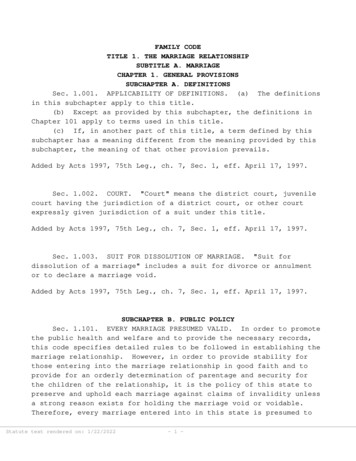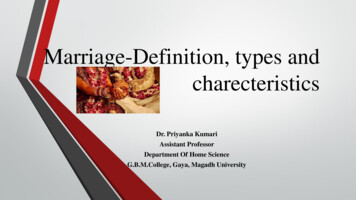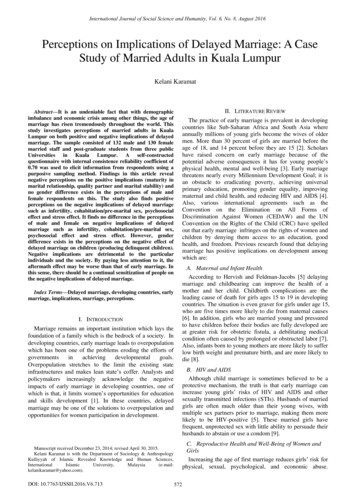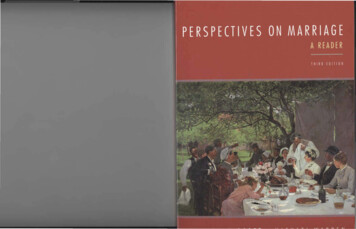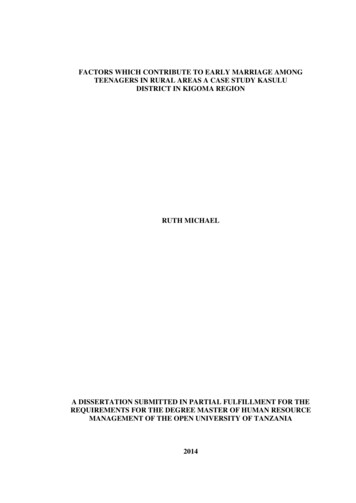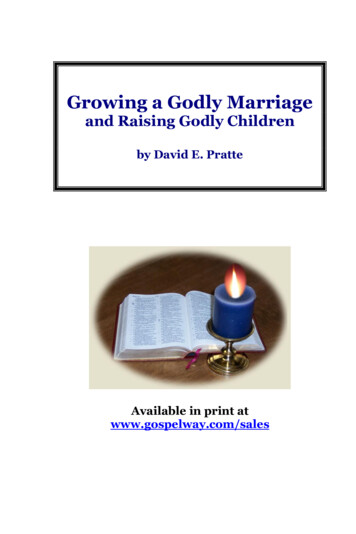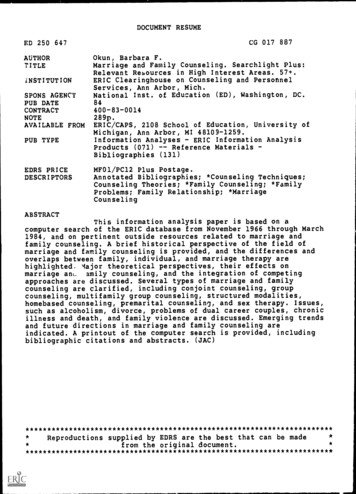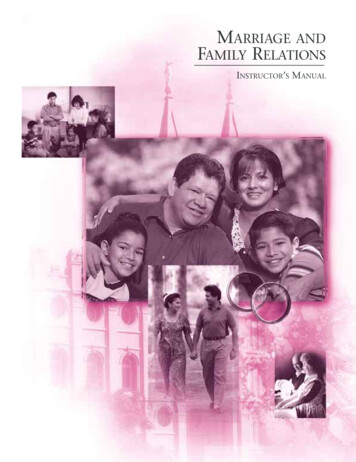
Transcription
MARRIAGE ANDFAMILY RELATIONSINSTRUCTOR’S MANUAL
MARRIAGE ANDFAMILY RELATIONSINSTRUCTOR’S MANUALPublished byThe Church of Jesus Christ of Latter-day SaintsSalt Lake City, Utah
Comments and SuggestionsYour comments and suggestions about this manual would be appreciated.Please submit them to:Curriculum Planning50 East North Temple Street, Floor 24Salt Lake City, UT 84150-3200USAE-mail: cur-development@ldschurch.orgPlease list your name, address, ward, and stake. Be sure to give the title ofthe manual. Then offer your comments and suggestions about the manual’sstrengths and areas of potential improvement. 2000 by Intellectual Reserve, Inc.All rights reservedPrinted in the United States of AmericaEnglish approval: 8/97
GENERAL INSTRUCTIONSHow should the Marriage and Family Relations course be used?This course is designed to help Church members strengthen marriages andfamilies and find joy in their family relationships. The bishopric or branchpresidency is responsible to see that the course is implemented effectively.Because Church members have different needs and come from different familysituations, the course is divided into two parts. Part A, “Strengthening Marriages,”is particularly helpful for married couples and for members who are preparing tobe married. Part B, “Parents’ Responsibilities to Strengthen Families,” assistsparents and grandparents in their efforts to “bring [children] up in the nurtureand admonition of the Lord” (Ephesians 6:4). Members who participate in thecourse should understand that they have the option to attend according to theirindividual needs. For example, a married couple without children may want toparticipate in part A but not in part B. A single parent may decide to participateonly in the lessons in part B.Ward and branch leaders may be flexible in their use of the course, accordingto the promptings of the Spirit and the needs of individual members. Theyshould consider the following ideas: Bishoprics and branch presidencies may schedule the course as a Sunday Schoolclass. As guided by the Spirit, leaders may invite specific members to attend. High priests group leaderships, elders quorum presidencies, and Relief Societypresidencies may use individual lessons for instruction on the first Sunday ofeach month. As appropriate, they may use the lessons for firesides and forteaching opportunities on weeknights or Saturdays. Bishoprics and branch presidencies may use individual lessons in combinedMelchizedek Priesthood–Relief Society meetings on fifth Sundays. They mayalso use the lessons in firesides for young men and women. Aaronic Priesthood and Young Women advisers may use the manual as aresource for Mutual night. They may use the lessons to teach the young menand women together or in their respective organizations. Individuals and couples may study the course on their own.Who should receive the materials for the course?Each of the ward or branch members listed below should receive one copy ofthe Marriage and Family Relations Instructor’s Manual and one copy of the Marriageand Family Relations Participant’s Study Guide:Bishop or branch presidentHigh priests group leaderElders quorum presidentYoung Men presidentRelief Society presidentYoung Women presidentMarriage and Family Relationscourse instructorEach participant in the course should receive a copy of the study guide.iii
CONTENTSGeneral Instructions . . . . . . . . . . . . . . . . . . . . . . . . . . . . . . . . . . . . . . . . . . . . . iii“The Family: A Proclamation to the World” . . . . . . . . . . . . . . . . . . . . . . . . viiiIntroduction . . . . . . . . . . . . . . . . . . . . . . . . . . . . . . . . . . . . . . . . . . . . . . . . . . . ixPurpose of This Course . . . . . . . . . . . . . . . . . . . . . . . . . . . . . . . . . . . . . . . . . . ixYour Responsibilities as a Teacher . . . . . . . . . . . . . . . . . . . . . . . . . . . . . . . . . ixDealing with Serious Family Problems . . . . . . . . . . . . . . . . . . . . . . . . . . . . . xiMaterials You Should Use . . . . . . . . . . . . . . . . . . . . . . . . . . . . . . . . . . . . . . . . xiAdditional Resources . . . . . . . . . . . . . . . . . . . . . . . . . . . . . . . . . . . . . . . . . . xiiPART A: STRENGTHENING MARRIAGES1. “The Family Is Central to the Creator’s Plan” . . . . . . . . . . . . . . . . . . . . . . 3Latter-day prophets proclaim the eternal importance of marriageand the family . . . . . . . . . . . . . . . . . . . . . . . . . . . . . . . . . . . . . . . . . . . . . . . 3Eternal marriage can bring joy and great blessings in this life andthroughout eternity . . . . . . . . . . . . . . . . . . . . . . . . . . . . . . . . . . . . . . . . . . . 4The Marriage and Family Relations course is designed to help usfind joy in our family relationships . . . . . . . . . . . . . . . . . . . . . . . . . . . . . . 6Our homes can be “a bit of heaven” as we build “upon the rock ofour Redeemer” . . . . . . . . . . . . . . . . . . . . . . . . . . . . . . . . . . . . . . . . . . . . . . . 72. Developing Unity in Marriage . . . . . . . . . . . . . . . . . . . . . . . . . . . . . . . . . . 9The Lord has commanded husbands and wives to be one . . . . . . . . . . . . . . . 9Husbands and wives are to value each other as equal partners . . . . . . . . . . . 9Husbands and wives should allow their individual characteristicsand abilities to complement one another . . . . . . . . . . . . . . . . . . . . . . . . 10Husbands and wives must be loyal to one another . . . . . . . . . . . . . . . . . . . 113. Nurturing Love and Friendship in Marriage . . . . . . . . . . . . . . . . . . . . . . 13Husbands and wives need to nurture their love for one another . . . . . . . . 13Expressions of affection and kindness keep love and friendshipalive in marriage . . . . . . . . . . . . . . . . . . . . . . . . . . . . . . . . . . . . . . . . . . . 13Proper intimacy in marriage is an expression of love . . . . . . . . . . . . . . . . . . 14Married couples should strive to have charity, the pure love of Christ . . . . 16v
4. Responding to Challenges in Marriage . . . . . . . . . . . . . . . . . . . . . . . . . . 18All married couples will experience challenges . . . . . . . . . . . . . . . . . . . . . 18Husbands and wives can work through any challenge if they viewmarriage as a covenant relationship . . . . . . . . . . . . . . . . . . . . . . . . . . . . . 19When challenges arise, we can choose to respond withpatience and love rather than frustration or anger . . . . . . . . . . . . . . . . . . 195. Responding to Challenges through Positive Communication . . . . . . . 23Every married couple will have some differences of opinion . . . . . . . . . . . . 23Husbands and wives should look for the admirable qualitiesin one another . . . . . . . . . . . . . . . . . . . . . . . . . . . . . . . . . . . . . . . . . . . . . . 23Positive communication helps prevent and resolve difficulties . . . . . . . . . . 246. Strengthening Marriages through Faith and Prayer . . . . . . . . . . . . . . . . 27Husbands and wives should work together to increasetheir faith in Jesus Christ . . . . . . . . . . . . . . . . . . . . . . . . . . . . . . . . . . . . . 27Husbands and wives are blessed when they pray together . . . . . . . . . . . . . . 287. The Healing Power of Forgiveness . . . . . . . . . . . . . . . . . . . . . . . . . . . . . . 31A spirit of forgiveness between husband and wife helpsbring peace and a feeling of trust and security . . . . . . . . . . . . . . . . . . . . . 31Husbands and wives should seek each other’s forgiveness fortheir shortcomings and make sincere efforts to improve . . . . . . . . . . . . 32Husbands and wives should seek to forgive one another . . . . . . . . . . . . . . . 338. Managing Family Finances . . . . . . . . . . . . . . . . . . . . . . . . . . . . . . . . . . . . 35Proper financial management is essential for a happy marriage . . . . . . . . . 35Husbands and wives should work together to follow basic principlesof money management . . . . . . . . . . . . . . . . . . . . . . . . . . . . . . . . . . . . . . . 36PART B: PARENTS’ RESPONSIBILITIES TO STRENGTHEN FAMILIES9. “Children Are an Heritage of the Lord” . . . . . . . . . . . . . . . . . . . . . . . . . . 43Heavenly Father entrusts His spirit children to earthly parents . . . . . . . . . . 43Parents should seek to meet each child’s individual needs . . . . . . . . . . . . . 44Children are entitled to a loving relationship with their parents . . . . . . . . 45Child abuse is an offense to God . . . . . . . . . . . . . . . . . . . . . . . . . . . . . . . . . . 46Children bring great joy into their parents’ lives . . . . . . . . . . . . . . . . . . . . . 4710. The Sacred Roles of Fathers and Mothers (Part 1: Fathers’ Roles) . . . . . 49Fathers and mothers should work together to provide each oftheir children with a shield of faith . . . . . . . . . . . . . . . . . . . . . . . . . . . . . 49Fathers are to preside in love and righteousness . . . . . . . . . . . . . . . . . . . . . . 50Fathers are to provide their families with the necessitiesof life and protection . . . . . . . . . . . . . . . . . . . . . . . . . . . . . . . . . . . . . . . . . 52vi
11. The Sacred Roles of Fathers and Mothers (Part 2: Mothers’ Roles) . . . . 54Mothers participate in God’s work . . . . . . . . . . . . . . . . . . . . . . . . . . . . . . . . 54Mothers are primarily responsible for the nurture of their children . . . . . . 55Fathers and mothers are to help one another as equal partners . . . . . . . . . . 5612. Teaching Children through Example and Instruction . . . . . . . . . . . . . . 58Parents are responsible to teach their children . . . . . . . . . . . . . . . . . . . . . . . 58Parents can receive inspiration in teaching their children . . . . . . . . . . . . . . 59Parents teach through example and instruction . . . . . . . . . . . . . . . . . . . . . 6013. Teaching Gospel Principles to Children (Part 1) . . . . . . . . . . . . . . . . . . . 63Parents’ teachings can help children stay strong in the faith . . . . . . . . . . . . 63Parents are to teach their children the first principles andordinances of the gospel . . . . . . . . . . . . . . . . . . . . . . . . . . . . . . . . . . . . . . 64Parents should “teach their children to pray, and to walk uprightlybefore the Lord” . . . . . . . . . . . . . . . . . . . . . . . . . . . . . . . . . . . . . . . . . . . . . 6514. Teaching Gospel Principles to Children (Part 2) . . . . . . . . . . . . . . . . . . . 67Parents show love for their children when they teach them . . . . . . . . . . . . 67Parents must teach children compassion and service . . . . . . . . . . . . . . . . . . 68Parents must teach children honesty and respect for others’ property . . . . 68Parents must teach children about the rewards of honest labor . . . . . . . . . 69Parents must teach children moral purity . . . . . . . . . . . . . . . . . . . . . . . . . . . 7015. Guiding Children As They Make Decisions . . . . . . . . . . . . . . . . . . . . . . . 73Children need guidance as they make decisions . . . . . . . . . . . . . . . . . . . . . 73Parents can help children exercise their agency righteously . . . . . . . . . . . . . 74Parents should allow children to learn from the consequencesof unwise decisions . . . . . . . . . . . . . . . . . . . . . . . . . . . . . . . . . . . . . . . 76Parents should show unfailing love for children who go astray . . . . . . . . . . 7716. Family Prayer, Family Scripture Study, and Family Home Evening . . . 79Family prayer and scripture study and family home eveningmust be high priorities for every Latter-day Saint family . . . . . . . . . . . . 79Families receive great blessings when they pray together . . . . . . . . . . . . . . . 80Family scripture study helps families draw nearer to God . . . . . . . . . . . . . . 80Family home evening helps families fortify themselves againstworldly influences . . . . . . . . . . . . . . . . . . . . . . . . . . . . . . . . . . . . . . . . . . . 82vii
THE FAMILYTHE FIRST PRESIDENCY AND COUNCIL OF THE TWELVE APOSTLESOF THE CHURCH OF JESUS CHRIST OF LATTER-DAY SAINTSWE, THE FIRST PRESIDENCY and the Council of theTwelve Apostles of The Church of Jesus Christ of Latterday Saints, solemnly proclaim that marriage between aman and a woman is ordained of God and that thefamily is central to the Creator’s plan for the eternaldestiny of His children.ALL HUMAN BEINGS—male and female—are created in theimage of God. Each is a beloved spirit son or daughter ofheavenly parents, and, as such, each has a divine natureand destiny. Gender is an essential characteristic of individual premortal, mortal, and eternal identity and purpose.IN THE PREMORTAL REALM, spirit sons and daughters knewand worshiped God as their Eternal Father and acceptedHis plan by which His children could obtain a physicalbody and gain earthly experience to progress toward perfection and ultimately realize his or her divine destiny asan heir of eternal life. The divine plan of happiness enablesfamily relationships to be perpetuated beyond the grave.Sacred ordinances and covenants available in holytemples make it possible for individuals to return to thepresence of God and for families to be united eternally.THE FIRST COMMANDMENT that God gave to Adam andEve pertained to their potential for parenthood as husband and wife. We declare that God’s commandment forHis children to multiply and replenish the earth remainsin force. We further declare that God has commandedthat the sacred powers of procreation are to be employed only between man and woman, lawfully weddedas husband and wife.WE DECLARE the means by which mortal life is created tobe divinely appointed. We affirm the sanctity of life and ofits importance in God’s eternal plan.HUSBAND AND WIFE have a solemn responsibility to loveand care for each other and for their children. “Childrenare an heritage of the Lord” (Psalms 127:3). Parents have asacred duty to rear their children in love and righteousness, to provide for their physical and spiritual needs, toteach them to love and serve one another, to observe thecommandments of God and to be law-abiding citizenswherever they live. Husbands and wives—mothers andfathers—will be held accountable before God for the discharge of these obligations.THE FAMILY is ordained of God. Marriage between manand woman is essential to His eternal plan. Children areentitled to birth within the bonds of matrimony, and to bereared by a father and a mother who honor marital vowswith complete fidelity. Happiness in family life is most likelyto be achieved when founded upon the teachings of theLord Jesus Christ. Successful marriages and families areestablished and maintained on principles of faith, prayer,repentance, forgiveness, respect, love, compassion, work,and wholesome recreational activities. By divine design,fathers are to preside over their families in love and righteousness and are responsible to provide the necessities oflife and protection for their families. Mothers are primarilyresponsible for the nurture of their children. In thesesacred responsibilities, fathers and mothers are obligatedto help one another as equal partners. Disability, death, orother circumstances may necessitate individual adaptation. Extended families should lend support when needed.WE WARNthat individuals who violate covenants ofchastity, who abuse spouse or offspring, or who fail tofulfill family responsibilities will one day stand accountable before God. Further, we warn that the disintegrationof the family will bring upon individuals, communities,and nations the calamities foretold by ancient andmodern prophets.WEresponsible citizens and officers ofgovernment everywhere to promote those measuresdesigned to maintain and strengthen the family as thefundamental unit of society.CALL UPONThis proclamation was read by President Gordon B. Hinckley as part of his message at theGeneral Relief Society Meeting held September 23, 1995, in Salt Lake City, Utah.viii
INTRODUCTIONPurpose ofThis CourseThe Marriage and Family Relations course is designed to help Church membersstrengthen marriages and families and find joy in their family relationships. Itis divided into two parts. Part A, “Strengthening Marriages,” is particularly helpful for married couples and for members who are preparing to be married. Part B,“Parents’ Responsibilities to Strengthen Families,” assists parents and grandparents in their efforts to “bring [children] up in the nurture and admonitionof the Lord” (Ephesians 6:4).The course is based on doctrines and principles taught in the scriptures andby latter-day prophets and apostles. It gives special emphasis to “The Family:A Proclamation to the World,” which is included on page viii.Your Responsibilitiesas a TeacherAs you ponder the eternal importance of marriage and the family and the greatneed to strengthen marriages and families, you will begin to comprehend theprofound importance of your calling to teach this course. Your dedication andprayerful preparation will bring blessings to you and your family as well as tothose who participate in the course. As you strive to magnify your calling,remember the principles outlined on this page and on pages x–xi.Prepare Yourself to TeachAs the instructor for this course, your responsibility is to teach the doctrines ofthe gospel by the power of the Holy Ghost. You do not need to have professionaltraining in family counseling, nor do you need to be able to find solutions toall the challenges that can occur in families. Class discussions should lead participants to ponder and pray about their own lives and make improvements intheir own families.For help with basic, essential principles of gospel teaching, such as personalpreparation, loving those you teach, and teaching by the Spirit, refer to thefollowing resources: “Gospel Teaching and Leadership,” section 16 of the Church Handbook ofInstructions, Book 2: Priesthood and Auxiliary Leaders (35209 or 35903). Teaching, No Greater Call (36123). Teaching Guidebook (34595).Remember the Broad Scope of the CourseBefore you teach the first lesson, take time to review the entire course. This willhelp you see how the lessons work together to strengthen marriages and families.As you prepare for each lesson, it will be helpful to review the table of contents(pages v–vii), which provides an overview of the course. Review what you haveix
already taught and learned, and ponder how the doctrines and principles ineach lesson support the course as a whole.Begin Lesson Preparation EarlyYour preparation will be more successful if you begin early for each lesson. Soonafter teaching a lesson, preview the next lesson. If you have an idea of what youwill be teaching, you will be able to ponder the lesson throughout the week. Thiscan help you be more aware of principles you should emphasize, methods youcan use, and experiences you can share.Select the Lesson Material That Will Best Meet Participants’ NeedsCarefully study the doctrines and principles in each lesson, seeking the guidanceof the Spirit to help you select the lesson material that will best meet participants’needs. Remember that “the success of a lesson is measured by its influence onthose you teach” (Teaching, No Greater Call [1999], 103).Determine How to Teach the LessonsIn addition to determining what you are going to teach in a lesson, it is importantto decide how you will teach it. You should always strive to teach in a way that willencourage participants to apply the doctrines and principles they learn.The lessons in this course should be given as discussions rather than lectures.Help members participate meaningfully in discussing the doctrines and principlesyou teach. The Lord’s counsel regarding class discussion is found in Doctrineand Covenants 88:122: “Appoint among yourselves a teacher, and let not all bespokesmen at once; but let one speak at a time and let all listen unto his sayings,that when all have spoken that all may be edified of all, and that every manmay have an equal privilege.” For information about conducting discussions,see pages 63–70 in Teaching, No Greater Call.As appropriate, use a variety of methods to help participants learn and understand the principles in the lessons. For example, look for opportunities to writeon the chalkboard, use object lessons, and display pictures. For help on how touse these and other methods, refer to pages 159–84 in Teaching, No Greater Call.Invite Participants to Apply What They LearnAs a gospel teacher, you must not be satisfied with merely sharing information,even if you do so in an original, engaging way. Your purpose is to help otherslive according to the doctrines and principles they learn. President Harold B. Lee,the 11th President of the Church, counseled:“All the principles and ordinances of the gospel are in a sense but invitationsto learning the gospel by the practice of its teachings. No person knows the principle of tithing until he pays tithing. No one knows the principle of the Wordof Wisdom until he keeps the Word of Wisdom. Children, or grownups for thatmatter, are not converted to tithing, the Word of Wisdom, keeping the Sabbathday holy, or prayer by hearing someone talk about these principles. We learn thegospel by living it. . . .“. . . We never really know anything of the teachings of the gospel until we haveexperienced the blessings that come from living each principle” (Stand Ye in HolyPlaces [1974], 215).x
IntroductionChurch magazines often contain inspiring stories illustrating how members ofthe Church have been blessed as they have lived the gospel. You can find storiesthat teach certain doctrines and principles by searching in the indexes of themagazines. Consider sharing some of these stories in class.At the conclusion of each lesson, invite participants to apply what they havelearned. Be sure to leave enough time to extend invitations that will inspirethem to take action. Plan ways to extend such invitations. For example, afterlesson 9, titled “Children Are an Heritage of the Lord,” you could review themain principles of the lesson and then invite participants to make a commitment to spend time alone with each of their children.Encourage Participants to Use the Study Guide for the CourseAs part of your preparation for each lesson, you should review the correspondingmaterial in the Marriage and Family Relations Participant’s Study Guide (36357).Plan ways to encourage participants to (1) follow at least one of the suggestionsin “Ideas for Application” and (2) read the article or articles that accompany eachlesson. Emphasize that married couples can receive great benefits from readingand discussing the articles in the study guide together.Participants should bring their study guides to class for each lesson.Respond to the Needs of Those Who Are Not in Traditional Family SituationsBe sensitive to the individual circumstances of participants, some of whommay be unmarried, widowed, divorced, or in other difficult family situations.Keep in mind the following statement by President Spencer W. Kimball, the12th President of the Church:“We . . . continue to hold up the ideal of the Latter-day Saint family. The factthat some do not now have the privilege of living in such a family is not reasonenough to stop talking about it. We do discuss family life with sensitivity,however, realizing that many . . . do not presently have the privilege of belongingor contributing to such a family. But we cannot set aside this standard, becauseso many other things depend upon it” (The Teachings of Spencer W. Kimball, ed.Edward L. Kimball [1982], 294–95).Dealing with SeriousFamily ProblemsWhile encouraging discussion, make sure participants understand that it isnot appropriate to share details of serious family problems. If participants seekcounsel about serious difficulties, gently encourage them to speak privatelywith the bishop. He will be able to counsel them. He may also recommendcounselors in LDS Family Services or community resources that provide helpthat is consistent with Church standards.Materials YouShould UseThe Church has produced sufficient resources to help you teach true doctrines andprinciples about marriage and the family. Please refrain from using commerciallyproduced materials in your preparation or your teaching. Your primary resourcesfor teaching the course are the scriptures, this manual, and the Marriage and FamilyRelations Participant’s Study Guide. Great thought and prayer have gone into thepreparation of the materials for this course.xi
AdditionalResourcesThe following Church-produced resources provide additional information onsubjects discussed in this course. These resources are available through Churchdistribution centers. You may want to encourage participants to use thesepublications in their families (they are listed on page vi in the Marriage andFamily Relations Participant’s Study Guide). Family Guidebook (31180). This guidebook describes the organization of thefamily, provides information about teaching the gospel in the home, andoutlines procedures for priesthood ordinances and blessings. Articles about marriage and the family in Church magazines. Family Home Evening Resource Book (31106). This book helps parents andchildren prepare lessons for family home evening (pages 3–160, 173–232).It contains ideas for making family home evening successful (pages 163–70)and includes suggestions for teaching specific principles and responsibilitiesto children (pages 235–62). It also contains ideas for family activities (pages265–340). Teaching, No Greater Call (36123). This resource contains principles and practical suggestions to help Church members improve as gospel teachers. Part D,“Teaching in the Home” (pages 125–48), is particularly helpful for parents. Teaching Guidebook (34595). This guidebook provides suggestions for improvinggospel teaching and learning. For the Strength of Youth (34285). This pamphlet outlines the Church’s standardsfor dating, dress and appearance, friendshipping, honesty, language, media,mental and physical health, music and dancing, sexual purity, Sunday behavior,repentance, worthiness, and service. A Parent’s Guide (31125). This handbook contains suggestions to help parentsteach their children about physical intimacy. Guidebook for Parents and Guardians of Handicapped Children (31123). Thisguidebook offers counsel for families with children who have disabilities. Italso contains information about Church-produced materials to help parentsand others teach those with disabilities. Cornerstones of a Happy Home (33108). This pamphlet contains an addressgiven by President Gordon B. Hinckley while he was serving as SecondCounselor in the First Presidency. Being a Righteous Husband and Father (35402). This pamphlet contains anaddress given by President Howard W. Hunter, the 14th President of theChurch. One for the Money: Guide to Family Finance (33293). This pamphlet, by ElderMarvin J. Ashton of the Quorum of the Twelve Apostles, provides practicalsuggestions on managing family finances.xii
PART ASTRENGTHENING MARRIAGES
“THE FAMILY IS CENTRALTO THE CREATOR’S PLAN”LESSON1PurposeTo emphasize the eternal importance of the family and to help participantsknow what they need to do to receive the full benefit of the Marriage and FamilyRelations course.Preparation1. Review the principles under “Your Responsibilities as a Teacher” (pages ix–xiin this manual). Look for ways to apply these principles in your preparationto teach.2. Read the lesson’s bold headings, which outline the doctrines and principles inthe lesson. As part of your preparation, ponder these doctrines and principlesthroughout the week, seeking the guidance of the Spirit in deciding what youshould emphasize to meet participants’ needs.3. Prayerfully study “The Family: A Proclamation to the World,” found on pageviii in this manual and page iv in the Marriage and Family Relations Participant’sStudy Guide.4. Obtain a copy of the Marriage and Family Relations Participant’s Study Guide(36357) for each participant. You should receive these copies from the SundaySchool presidency, the ward clerk, or the assistant ward clerk assigned tomaterials.5. In advance, ask one or two participants to prepare to talk briefly about howthey felt when they were married in the temple. Also ask them to prepare totalk about the joy and blessings they receive in this life because they have beensealed to their spouse for eternity. Seek the guidance of the Spirit as you decidewhom you should ask to fulfill this assignment.6. Before class, write on the chalkboard the following quotation (from Stand Yein Holy Places [1974], 255):The most important of the Lord’s work you and I will ever do will be within the wallsof our own homes.President Harold B. Lee11th President of the ChurchSuggested LessonDevelopmentLatter-day prophets proclaim the eternal importance of marriage and thefamily.Share the following true story:A man seemed to have lost everything in a disastrous flood. He wept, not forthe loss of his worldly goods, but because he could not locate his beloved wifeand four children. There was a very real possibility that they had drowned. Soonthe word came that they were alive and waiting for him at a nearby emergencyfacility. What a joyous moment when that family was brought together again!3
As they rejoiced, the man said, “I have my family again, and although I standwithout one earthly possession left to my name, I feel like a millionaire” (quotedby Robert L. Simpson, in Conference Report, Oct. 1980, 11–12; or Ensign, Nov.1980, 11).Briefly share your convictions and testimony about marriage and the family. Asappropriate, share your feelings about your own family. Then read the followingstatement by Elder Boyd K. Packer of the Quorum of the Twelve Apostles:“The center core of the Church is not the stake [center
the Marriage and Family Relations Instructor's Manual and one copy of the Marriage and Family Relations Participant's Study Guide: Bishop or branch president Relief Society president High priests group leader Young Women president Elders quorum president Marriage and Family Relations Young Men president course instructor


